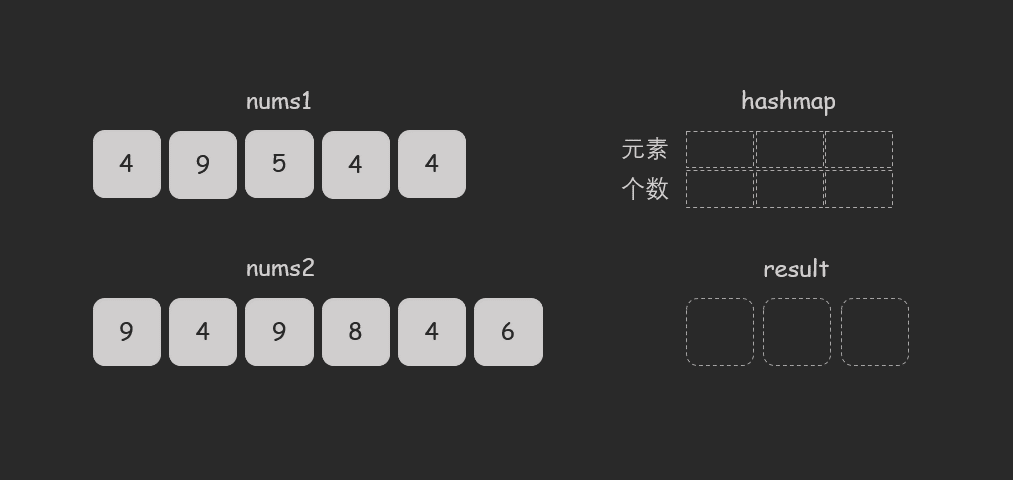Hash Table
Hash Table(哈希表)是一种在数组类型题目非常常见的解题方法。本质是一个数组的数据结构,只不过存放的是键值对。
不同的 key 通过 hash 函数可能得到相同的索引值,这个计算索引的过程被称为 哈希(hash)。
哈希表的基本操作
大多数情况下我们使用哈希表的目的是快速查找,由于结构的特殊性,哈希表的查找速度非常快,时间复杂度为 O(1)。
简单实现:
const hash = []
hash[1] = 1
hash[2] = 2
hash[3] = 3
console.log(hash[1]) // 1
// 也可以使用对象,使用对象的好处是可以使用字符串作为 key
const hash = {}
hash[1] = 1
hash[2] = 2
hash[3] = 3
console.log(hash[1]) // 1
// 也可以使用 Map,使用 Map 的好处是可以使用任意类型作为 key
const hash = new Map()
hash.set(1, 1)
hash.set(2, 2)
hash.set(3, 3)
console.log(hash.get(1)) // 1
// 也可以使用 Set,但是需要注意的是,Set 中的元素是唯一的,如果重复添加,会被忽略
const hash = new Set()
hash.add(1)
hash.add(2)
hash.add(3)
console.log(hash.has(1)) // true
简单应用场景
哪怕知道原理,在不同的问题下,会存在一些细微的差异,这里举几个示例讲讲 Hash Table 的一些基础应用。
- 计算两个有序整型数组的交集
处理思路:
顺序遍历两个数组,将数组元素存放到哈希表中,同时对统计的数组元素进行计数。如果某个元素的计数器的值为 2,则该元素为两者的交集元素。

题解:
/**
* @param {number[]} nums1
* @param {number[]} nums2
* @return {number[]}
*/
const intersect = function (nums1, nums2) {
const hash = {}
const result = []
for (const num of nums1)
hash[num] = hash[num] ? hash[num] + 1 : 1
for (const num of nums2) {
if (hash[num]) {
result.push(num)
hash[num]--
}
}
return result
}
class Solution {
public:
vector<int> intersect(vector<int>& nums1, vector<int>& nums2) {
unordered_map<int, int> hash;
vector<int> result;
for (int num : nums1) {
hash[num]++;
}
for (int num : nums2) {
if (hash[num] > 0) {
result.push_back(num);
hash[num]--;
}
}
return result;
}
};
class Solution {
public int[] intersect(int[] nums1, int[] nums2) {
Map<Integer, Integer> hash = new HashMap<>();
List<Integer> result = new ArrayList<>();
for (int num : nums1) {
hash.put(num, hash.getOrDefault(num, 0) + 1);
}
for (int num : nums2) {
if (hash.containsKey(num) && hash.get(num) > 0) {
result.add(num);
hash.put(num, hash.get(num) - 1);
}
}
return result.stream().mapToInt(Integer::valueOf).toArray();
}
}
class Solution:
def intersect(self, nums1: List[int], nums2: List[int]) -> List[int]:
hash = {}
result = []
for num in nums1:
hash[num] = hash.get(num, 0) + 1
for num in nums2:
if hash.get(num):
result.append(num)
hash[num] -= 1
return result
- 找出数组中重复次数最多的数
处理思路:
使用 map 映射表,通过引入 map 表或对象来记录每个元素出现的次数,然后判断每个数出现的次数,进而找出重复次数最多的元素。
题解:
/**
* @param {number[]} nums
* @return {number}
*/
const findRepeatNumber = function (nums) {
const hash = new Map()
for (const num of nums) {
if (hash.get(num))
return num
hash.set(num, true)
}
}
class Solution {
public:
int findRepeatNumber(vector<int>& nums) {
unordered_map<int, bool> hash;
for (int num : nums) {
if (hash[num]) {
return num;
}
hash[num] = true;
}
return -1;
}
};
class Solution {
public int findRepeatNumber(int[] nums) {
Map<Integer, Boolean> hash = new HashMap<>();
for (int num : nums) {
if (hash.containsKey(num)) {
return num;
}
hash.put(num, true);
}
return -1;
}
}
class Solution:
def findRepeatNumber(self, nums: List[int]) -> int:
hash = {}
for num in nums:
if hash.get(num):
return num
hash[num] = True
return -1
- O(n)的时间复杂度内找出数组中出现次数超过了一半的数
处理思路:
首先创建一个 map 对象,其中,key 为数组元素值,value 为此数出现的次数。遍历一遍数组,用 hash_map 统计每个数出现的次数,并用两个值存储目前出现次数最多的数和对应出现的次数,此时的时间复杂度为 O(n),空间复杂度为 O(n),满足题目的要求。
题解:
/**
* @param {number[]} nums
* @return {number}
*/
const majorityElement = function (nums) {
const hash = new Map()
let max = 0
let result = 0
for (const num of nums) {
let count = hash.get(num) || 0
count++
hash.set(num, count)
if (count > max) {
max = count
result = num
}
}
return result
}
class Solution {
public:
int majorityElement(vector<int>& nums) {
unordered_map<int, int> hash;
int max = 0;
int result = 0;
for (int num : nums) {
int count = hash[num] ? hash[num] : 0;
count++;
hash[num] = count;
if (count > max) {
max = count;
result = num;
}
}
return result;
}
};
class Solution {
public int majorityElement(int[] nums) {
Map<Integer, Integer> hash = new HashMap<>();
int max = 0;
int result = 0;
for (int num : nums) {
int count = hash.getOrDefault(num, 0);
count++;
hash.put(num, count);
if (count > max) {
max = count;
result = num;
}
}
return result;
}
}
class Solution:
def majorityElement(self, nums: List[int]) -> int:
hash = {}
max = 0
result = 0
for num in nums:
count = hash.get(num) or 0
count += 1
hash[num] = count
if count > max:
max = count
result = num
return result
- 找出数列中符合条件的数对的个数
题目描述:
在整数数组中,如果一个整数的出现频次和它的数值大小相等,我们就称这个整数为「幸运数」。给你一个整数数组 arr,请你从中找出并返回一个幸运数。
解题思路:
使用 map 映射表,通过引入 map 表或对象来记录,元素值与每个元素出现的次数,然后判断每个数出现的次数,进而找出符合条件的数对。
题解:
/**
* @param {number[]} arr
* @return {number}
*/
const findLucky = function (arr) {
const hash = new Map()
for (const num of arr) {
let count = hash.get(num) || 0
count++
hash.set(num, count)
}
let result = -1
for (const [key, value] of hash) {
if (key === value)
result = Math.max(result, key)
}
return result
}
class Solution {
public:
int findLucky(vector<int>& arr) {
unordered_map<int, int> hash;
for (int num : arr) {
int count = hash[num] ? hash[num] : 0;
count++;
hash[num] = count;
}
int result = -1;
for (auto [key, value] : hash) {
if (key == value) {
result = max(result, key);
}
}
return result;
}
};
class Solution {
public int findLucky(int[] arr) {
Map<Integer, Integer> hash = new HashMap<>();
for (int num : arr) {
int count = hash.getOrDefault(num, 0);
count++;
hash.put(num, count);
}
int result = -1;
for (Map.Entry<Integer, Integer> entry : hash.entrySet()) {
if (entry.getKey().equals(entry.getValue())) {
result = Math.max(result, entry.getKey());
}
}
return result;
}
}
class Solution:
def findLucky(self, arr: List[int]) -> int:
hash = {}
for num in arr:
count = hash.get(num) or 0
count += 1
hash[num] = count
result = -1
for key, value in hash.items():
if key == value:
result = max(result, key)
return result
总结
本章中,我们了解了哈希表的基本概念,以及哈希表的基本操作,和哈希表的简单应用场景。本文中的例题,都是非常基础和经典的题目,如果感觉已经掌握了,可以尝试一下本章的其它题目,加深对哈希表的理解。
- 1. 两数之和 :非常经典的哈希表应用题目,面试频率极高,可以作为刷题的基础题目。
- 3. 无重复字符的最长子串:字符串和哈希表的结合应用,面试中经常会遇到。
- 136. 只出现一次的数字:找出现次数的题型。
- 349. 两个数组的交集:数组交集的题型。
- 560. 和为 K 的子数组:找出数列中符合条件的数对个数的题型。